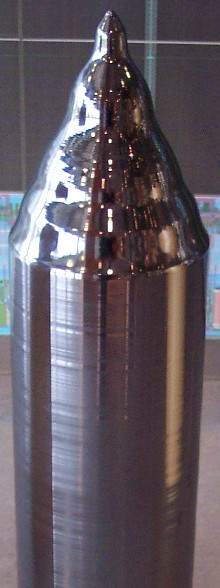利用者:加藤勝憲/ブール(クリスタル)

ブールとは、人工的に作られた単結晶のインゴットである。[1]
A boule is a single-crystal ingot produced by synthetic means.[1]
シリコンの塊は、今日使用されているほとんどの集積回路の原料である。半導体業界では、ブリッジマン法[2]やチョクラルスキー法など、さまざまな方法で人工の塊を作ることができる。その結果、円筒形の材料が得られる。
A boule of silicon is the starting material for most of the integrated circuits used today. In the semiconductor industry synthetic boules can be made by a number of methods, such as the Bridgman technique[2] and the Czochralski process, which result in a cylindrical rod of material.
チョクラルスキー法では、より大きな結晶やインゴットを作成するために種結晶が必要となる。この種結晶を純粋な溶融シリコンに浸し、ゆっくりと引き上げる。溶融シリコンは種結晶上で結晶状に成長する。種結晶を引き上げるとシリコンが凝固し、最終的に大きな円筒形の塊が生成される。[3]
In the Czochralski process a seed crystal is required to create a larger crystal, or ingot. This seed crystal is dipped into the pure molten silicon and slowly extracted. The molten silicon grows on the seed crystal in a crystalline fashion. As the seed is extracted the silicon solidifies and eventually a large, cylindrical boule is produced.[3]
半導体結晶の塊は通常、内孔ダイヤモンドソーまたはダイヤモンドワイヤーソーを使用して円形のウェハーに切断され、各ウェハーは表面に半導体デバイスの製造に適した基板を提供するためにラップ加工および研磨される。[4]
A semiconductor crystal boule is normally cut into circular wafers using an inside hole diamond saw or diamond wire saw, and each wafer is lapped and polished to provide substrates suitable for the fabrication of semiconductor devices on its surface.[4]
このプロセスは、青色および白色LEDの製造における基板、特殊用途の光学窓、時計の保護カバーとして使用されるサファイアの製造にも使用されている。[5]
The process is also used to create sapphires, which are used for substrates in the production of blue and white LEDs, optical windows in special applications and as the protective covers for watches.[5]
出典
[編集]- ^ Kimoto, Tsunenobu; Cooper, James A. (24 November 2014). Fundamentals of Silicon Carbide Technology: Growth, Characterization. John Wiley & Sons. ISBN 9781118313527 March 1, 2017閲覧。
- ^ Dhanaraj, Govindhan; Byrappa, Kullaiah; Prasad, Vishwanath; Dudley, Michael (2010). Springer Handbook of Crystal Growth. Springer. ISBN 9783540747611 February 25, 2017閲覧。
- ^ Rea (1978年). “Continuous Czochralski Process Development”. March 1, 2017閲覧。
- ^ BOSE (2013). IC Fabrication Technology. McGraw Hill Education (India) Pvt Ltd. pp. 53. ISBN 978-1-259-02958-5
- ^ J.-P. Colinge (29 February 2004). Silicon-on-Insulator Technology: Materials to VLSI: Materials to Vlsi. Springer Science & Business Media. pp. 12. ISBN 978-1-4020-7773-9
[[Category:結晶]]
